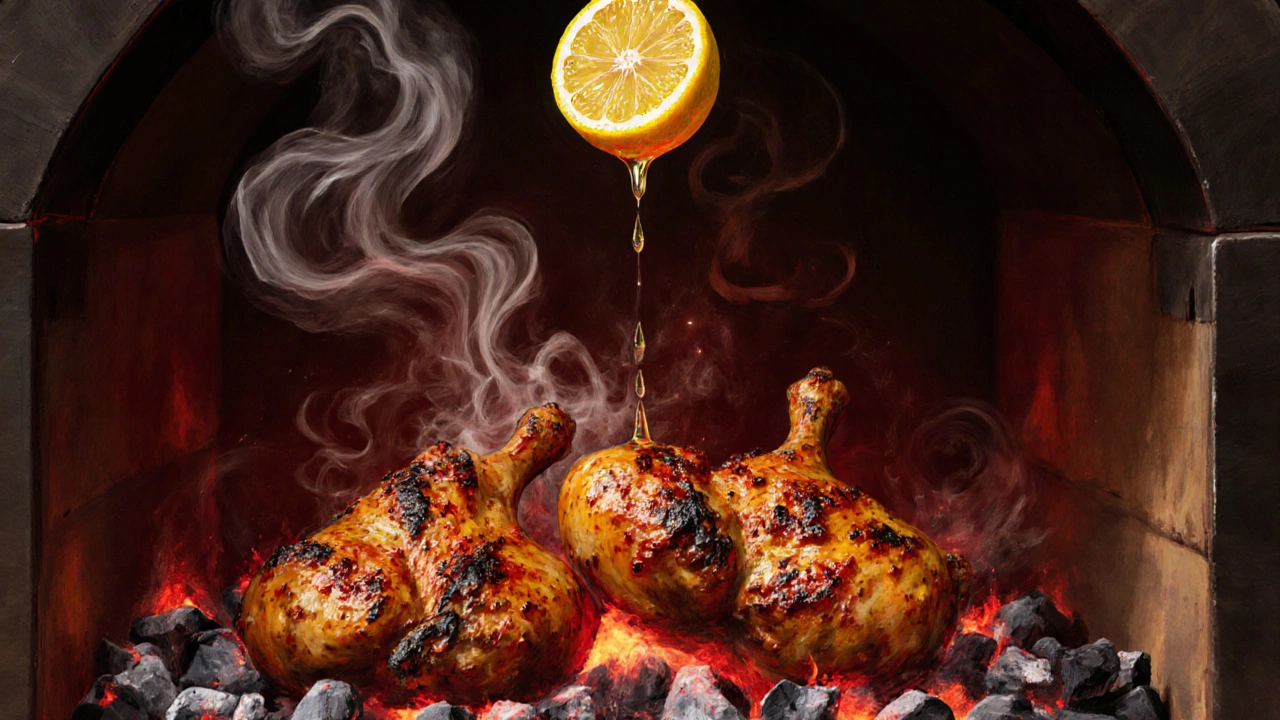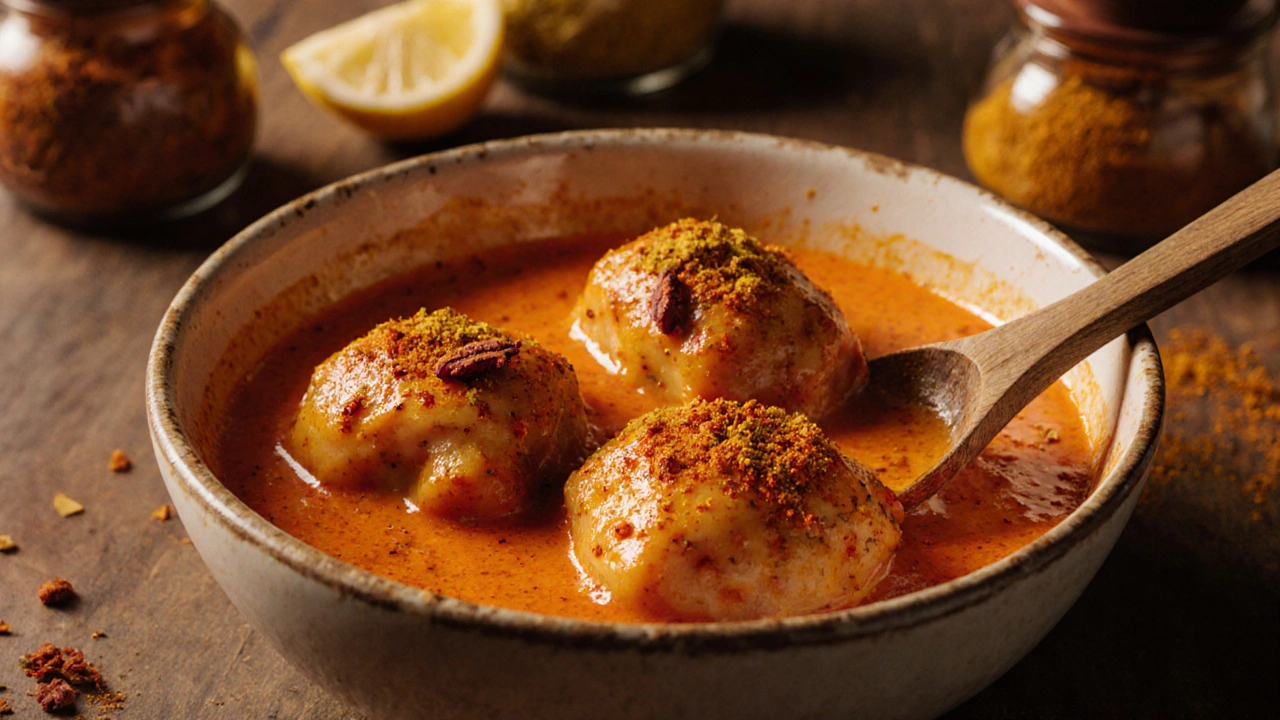Tandoori Chicken Marinade Calculator
Create Your Perfect Marinade
Calculate ingredient ratios based on chicken weight and spice preference. Follow the article's science behind yogurt, spices, and acid for authentic tandoori flavor.
When you bite into a piece of tandoori chicken, the first thing you taste isn’t just the spice-it’s the marinade. That deep, smoky, tangy flavor doesn’t come from the grill alone. It comes from three simple ingredients working together: yogurt, spices, and acid. Skip any one of them, and you’re not making tandoori chicken-you’re making spiced grilled chicken.
Yogurt: The Base That Makes It Stick
Yogurt isn’t just a carrier for spices. It’s the secret weapon that tenderizes the chicken and locks in moisture. The lactic acid in plain, full-fat yogurt gently breaks down muscle fibers without turning the meat mushy, like vinegar or lemon juice might. It also creates a sticky coating that holds the spices in place during cooking.
Use plain, unsweetened yogurt-no vanilla, no fruit, no sugar. Greek yogurt works too, but it’s thicker, so you might need to thin it with a splash of water or milk. Indian dahi (curd) is ideal because it’s naturally tangier and less processed than Western yogurts. A good rule of thumb: use about 1 cup of yogurt for every 1.5 pounds of chicken. Too little, and the spices won’t cling. Too much, and the marinade won’t caramelize properly on the grill.
Spices: The Soul of the Flavor
Spices are what turn plain chicken into tandoori chicken. But not just any mix will do. The classic blend includes ground cumin, coriander, turmeric, paprika or Kashmiri red chili powder, garam masala, and garlic powder. Some recipes add fenugreek leaves (kasuri methi) for that signature earthy note.
Turmeric gives the bright orange-red color, but don’t rely on it alone. Kashmiri chili powder delivers rich color without burning heat, while regular paprika or cayenne adds punch. Garam masala is added toward the end of marinating-it’s too delicate to sit for hours. If you use whole spices, toast and grind them fresh. Pre-ground spices lose their oils fast. A 2023 study from the Indian Institute of Food Processing Technology found that freshly ground spices retained 40% more volatile flavor compounds after 24 hours than store-bought powder.
Don’t just sprinkle the spices on. Mix them into the yogurt first, then coat the chicken. This lets the oils bind with the fat in the yogurt, creating a paste that clings evenly. Skip this step, and you’ll end up with uneven color and flavor-some bites spicy, some bland.
Acid: The Hidden Catalyst
Yogurt gives you acid, but it’s not enough. A splash of lemon juice or vinegar-usually about 1 to 2 tablespoons per cup of yogurt-activates the enzymes in the yogurt and boosts tenderizing power. It also brightens the whole flavor profile, cutting through the richness of the spices and fat.
Lemon juice is the most common choice because it’s clean and fruity. But if you’re out, apple cider vinegar or even tamarind paste work. Tamarind adds a subtle sweetness that balances the heat. Avoid strong vinegars like white distilled-they overpower. And never use citrus zest in the marinade; it doesn’t dissolve and leaves bitter bits on the chicken.
The acid also helps preserve the color. Without it, the turmeric and chili fade faster during marinating. A 2022 test by a Delhi-based food lab showed that chicken marinated with lemon juice retained 85% of its red-orange hue after 12 hours, while chicken without acid faded to dull brown by hour 8.

Why These Three? The Science Behind the Blend
Yogurt, spices, and acid aren’t just tradition-they’re chemistry. Each plays a role the others can’t replicate.
- Yogurt provides moisture retention, enzymatic tenderizing, and a sticky base.
- Spices deliver aroma, color, and layered flavor through compounds like curcumin, carvacrol, and eugenol.
- Acid activates enzymes, enhances spice solubility, and stabilizes pigment molecules.
Try substituting one: Use buttermilk instead of yogurt? Fine. Use soy sauce instead of lemon? Not the same-it adds salt and umami, not brightness. Skip the acid entirely? The color dulls, the texture gets dense, and the flavor feels flat.
Common Mistakes People Make
Even with the right ingredients, people mess up the process.
- Using low-fat yogurt: It’s watery and doesn’t cling. The chicken ends up steaming instead of searing.
- Marinating for less than 4 hours: The spices don’t penetrate. Even 2 hours isn’t enough for thick pieces like drumsticks.
- Adding oil to the marinade: Oil repels water-based yogurt. It creates slick spots where spices won’t stick.
- Using pre-mixed tandoori powder: Most store-bought blends are too salty and lack depth. They’re made for convenience, not flavor.
- Not patting the chicken dry before cooking: Wet marinade = steam, not char. Always dry the surface with paper towels before grilling.

Pro Tip: The Overnight Method
If you have time, marinate overnight. But don’t just dump everything in the fridge and walk away. Mix the yogurt, spices, and acid in a bowl first. Let it sit for 15 minutes-this lets the spices bloom. Then add the chicken. Cover and refrigerate for 8-12 hours. The yogurt will continue to tenderize slowly, and the spices will deepen into the meat.
When you’re ready to cook, let the chicken sit at room temperature for 30 minutes. Cold chicken won’t sear properly. Grill over medium-high heat, turning occasionally. The yogurt will char slightly-those blackened bits? That’s flavor.
What If You Don’t Have Yogurt?
There’s no perfect substitute. But if you’re out, here’s the closest alternative: mix 1 cup of buttermilk with 1 tablespoon of lemon juice and 1 teaspoon of cornstarch. The cornstarch thickens it to mimic yogurt’s cling. It won’t be the same, but it’ll still work in a pinch.
Don’t use sour cream or crème fraîche-they’re too rich and won’t tenderize properly. Don’t use milk. It has no acid or enzymes. And don’t try to skip the yogurt entirely. You’ll lose the texture, the color, and the soul of the dish.
Final Thought: It’s Not About the Recipe, It’s About the Balance
Tandoori chicken isn’t about following a rigid list of spices. It’s about understanding how yogurt, acid, and spices interact. Get that balance right, and you can tweak the heat, the herbs, even the cut of chicken-and it’ll still taste like tandoori. Mess up one of the three, and you’re just eating grilled chicken with a colorful crust.
Can I use milk instead of yogurt for tandoori chicken marinade?
No. Milk lacks the acidity and probiotics needed to tenderize the meat. It won’t cling to the chicken, and the spices will wash off. You’ll end up with bland, dry chicken. Yogurt’s lactic acid and thick texture are irreplaceable in this recipe.
How long should I marinate tandoori chicken?
At least 4 hours, but 8-12 hours is ideal. Overnight marinating gives the best flavor penetration and tenderness. If you’re short on time, 2 hours will still help, but the color and depth won’t be as strong. Don’t go beyond 24 hours-the yogurt can start to break down the meat too much.
Why is my tandoori chicken not red?
The red color comes from Kashmiri chili powder or paprika, not turmeric. If your chicken isn’t red, you’re probably using too little chili or old spices. Fresh Kashmiri chili powder gives a vibrant, deep red. If you can’t find it, mix 1 part paprika with 1/2 part cayenne. Also, make sure you added lemon juice-without acid, the color fades quickly.
Can I bake tandoori chicken instead of grilling it?
Yes. Preheat your oven to 475°F (245°C) and place the chicken on a wire rack over a baking sheet. This lets air circulate so the marinade crisps instead of steaming. Bake for 20-25 minutes, then broil for 3-5 minutes to char the edges. It won’t have the exact smoky taste, but it’ll still be juicy and flavorful.
Do I need to add oil to the marinade?
No. Oil makes the marinade slippery and prevents the yogurt-spice paste from sticking to the chicken. Traditional tandoori marinades don’t include oil. The fat comes from the chicken skin or is added during cooking if needed. Skip the oil for better texture and flavor absorption.
